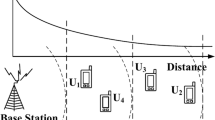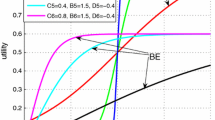Abstract
To efficiently support quality of service (QoS) in future wireless networks, it is important to model a wireless channel in terms of connection-level QoS metrics such as data rate, delay and delay-violation probability. To achieve this, in [7], we proposed and developed a link-layer channel model termed effective capacity (EC) for flat fading channels. In this paper, we apply the effective capacity technique to modeling frequency selective fading channels. Specifically, we utilize the duality between the distribution of a queue with superposition of N i.i.d. sources, and the distribution of a queue with a frequency-selective fading channel that consists of N i.i.d. sub-channels, to model a frequency selective fading channel. In the proposed model, a frequency selective fading channel is modeled by three EC functions; we also propose a simple and efficient algorithm to estimate these EC functions. Simulation results show that the actual QoS metric is closely approximated by the QoS metric predicted by the proposed EC channel model. The accuracy of the prediction using our model can translate into efficiency in admission control and resource reservation.
Similar content being viewed by others
References
D. Botvich and N. Duffield, “Large deviations, the shape of the loss curve, and economies of scale in large multiplexers,” Queueing Systems, Vol. 20 (1995) pp. 293–320.
G. L. Choudhury, D. M. Lucantoni, and W. Whitt, “Squeezing the most out of ATM,” IEEE Transactions on Communications, Vol. 44, No. 2 (Feb. 1996) pp. 203–217.
H. Holma and A. Toskala, WCDMA for UMTS: Radio Access for Third Generation Mobile Communications, Wiley, 2000.
Y. Y. Kim and S.-Q. Li, “Capturing important statistics of a fading/shadowing channel for network performance analysis,” IEEE Journal on Selected Areas in Communications, Vol. 17, No. 5 (May 1999) pp. 888–901.
T. S. Rappaport, Wireless Communications: Principles & Practice, Prentice Hall, 1996.
B. Sklar, “Rayleigh fading channels in mobile digital communication systems Part I: characterization,” IEEE Communications Magazine, Vol. 35, No. 7 (July 1997) pp. 90–100.
D. Wu and R. Negi, “Effective capacity: a wireless link model for support of quality of service,” IEEE Trans. on Wireless Communications, Vol. 2, No. 4 (July 2003) pp. 630–643.
D. Wu and R. Negi, “Utilizing multiuser diversity for efficient support of quality of service over a fading channel,” IEEE ICC'03, Anchorage, Alaska, USA, May 2003.
D. Wu and R. Negi, “Downlink scheduling in a cellular network for quality of service assurance,” Proc. IEEE Vehicular Technology Conference (VTC) Fall 2003, Orlando, Florida, USA, October 2003.
D. Wu, “Providing quality of service guarantees in wireless networks,” Ph.D. Dissertation, Dept. of Electrical & Computer Engineering, Carnegie Mellon University, Aug. 2003. Available at http://www.wu.ece.ufl.edu/mypapers/Thesis.pdf.
Q. Zhang and S. A. Kassam, “Finite-state markov model for Rayleigh fading channels,” IEEE Trans. Commun., Vol. 47, No. 11 (Nov. 1999) pp. 1688–1692.
M. Zorzi, R. R. Rao, and L. B. Milstein, “Error statistics in data transmission over fading channels,” IEEE Trans. Commun., Vol. 46, No. 11 (Nov. 1998) pp. 1468–1477.
M. Zorzi, A. Chockalingam, and R. R. Rao, “Throughput analysis of TCP on channels with memory,” IEEE Journal on Selected Areas in Communications, Vol. 18, No. 7 (July 2000) pp. 1289–1300.
Author information
Authors and Affiliations
Corresponding author
Additional information
Dapeng Wu received B.E. in Electrical Engineering from Huazhong University of Science and Technology, Wuhan, China, in 1990, M.E. in Electrical Engineering from Beijing University of Posts and Telecommunications, Beijing, China, in 1997, and Ph.D. in Electrical and Computer Engineering from Carnegie Mellon University, Pittsburgh, PA, in 2003. From July 1997 to December 1999, he conducted graduate research at Polytechnic University, Brooklyn, New York. During the summers of 1998, 1999 and 2000, he conducted research at Fujitsu Laboratories of America, Sunnyvale, California, on architectures and traffic management algorithms in the Internet and wireless networks for multimedia applications.
Since August 2003, he has been with Electrical and Computer Engineering Department at University of Florida, Gainesville, FL, as an Assistant Professor. His research interests are in the areas of networking, communications, multimedia, signal processing, and information and network security. He received the IEEE Circuits and Systems for Video Technology (CSVT) Transactions Best Paper Award for Year 2001.
Currently, he is an Associate Editor for the IEEE Transactions on Vehicular Technology and Associate Editor for International Journal of Ad Hoc and Ubiquitous Computing. He served as Program Chair for IEEE/ACM First International Workshop on Broadband Wireless Services and Applications (BroadWISE 2004); and as TPC member of over 30 conferences. He is Vice Chair of Mobile and wireless multimedia Interest Group (MobIG), Technical Committee on Multimedia Communications, IEEE Communications Society. He is a member of the Best Paper Award Committee, Technical Committee on Multimedia Communications, IEEE Communications Society. He is also Director of Communications, IEEE Gainesville Section.
Rohit Negi received the B.Tech. degree in Electrical Engineering from the Indian Institute of Technology, Bombay, India in 1995. He received the M.S. and Ph.D. degrees from Stanford University, CA, USA, in 1996 and 2000 respectively, both in Electrical Engineering. He has received the President of India Gold medal in 1995.
Since 2000, he has been with the Electrical and Computer Engineering department at Carnegie Mellon University, Pittsburgh, PA, USA, where he is an Associate Professor. His research interests include signal processing, coding for communications systems, information theory, networking, cross-layer optimization and sensor networks.
Rights and permissions
About this article
Cite this article
Wu, D., Negi, R. Effective capacity channel model for frequency-selective fading channels. Wireless Netw 13, 299–310 (2007). https://doi.org/10.1007/s11276-006-7526-x
Published:
Issue Date:
DOI: https://doi.org/10.1007/s11276-006-7526-x




